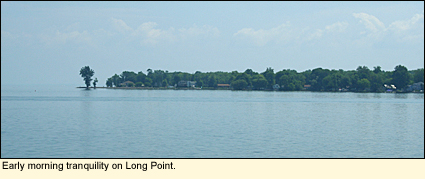Home > Basics > LakesOneida LakeCoordinates: 43.207°N 75.°W Elevation: 369 feet/112.4 meters
Named for the Oneida Indians that still live near the lake, Oneida Lake is about 21 mi./33.8 km. long and 5 mi./8 km. wide. It is thought that the lake is the last vestige of the ancient Iroquois Lake that occurred when a glacier dammed the St. Lawrence River and flooded much of Central New York State.
The lake is generally oval in shape and runs pretty much east to west. Fed by Fish Creek from the east, it drains northwest via the Oneida River, into the Oswego River, which drains into Lake Ontario. At 22 ft./6.7 m. deep, it is much more shallow than the Finger Lakes and, consequently, has warmer water in the summer. Parts of Oneida Lake can be found in six counties with only a very small portion--the southwestern shore--actually residing in the Finger Lakes Region. HISTORYThe Oneidas were the first humans known to frequent the lake. They called it Tsioqui--"white water," thought to be a reference to the lake's waves. They trapped, hunted, and fished in the region. In the lake, they would have found Atlantic salmon, eels, catfish, and pike. Birds would have been plentiful, especially during migration. In the surrounding woods there would have been deer, bear, wood bison, mountain lions, wolves, and even elk. In nearby Cicero Swamp there would have been, and still is, the massasauga rattlesnake.
In the early 1800s the lake became a link between the Oneida River on the west and the Erie Canal on the east for trade to New York City. Barges and tugs plied the lake's waters and Brewerton, at the west end of the lake, and many other towns became active canal ports. Later a trolley line ran between Syracuse and South Bay, bringing tourists to the lake for rides on steamboats like the Manhattan and the Sagamore.
Today many people live on the lake year 'round and commute in their SUVs to work in Syracuse. ECOLOGYOneida Lake has been studied extensively by both Syracuse and Cornell universities. A considerable amount of information is available about the lake's watershed and its ecology.
When the glaciers receded, leaving behind what is now Oneida Lake, swamps like Cicero Swamp developed. Besides dense vegetation, these swamps contain muck and peat. A small portion of the original Cicero Swamp is owned by the state and is a wildlife management unit.
The lake is populated with more than 120 forms of algae. During warm weather you can sometimes see algae blooms on the lake, which caused French Canadians to refer to the lake as le lac vert--"the green lake." Early American settlers believed that drinking the water during these blooms would give you "lake fever."
The lake's algae are eaten by zooplankton--the most common of which is Daphnia--zebra mussels, and small fish. The zooplankton are eaten by small fish. The small fish are eaten by medium-sized fish and birds like kingfishers, gulls, and common terns. The medium-sized fish are eaten by large fish and birds like herons, cormorants, and osprey. The large fish are eaten by....
Today the lake is said to support 74 species of fish, many of them introduced, but the Atlantic salmon and the eels are gone. Sturgeon are indigenous to the lake. In 1856, it was reported that a 7-foot/2-meter sturgeon weighing 104 pounds was caught in the Oneida River. The last record of a sturgeon of any size was in 1973 and that one only 40 pounds.
Angling is dying a natural death as more and more people become interested in preserving and observing nature. It seems that every other SUV is carrying a kayak. Birding is extremely popular in the Finger Lakes. And seminars are being given in the newest wildlife-watching activity--dragonflies and damselflies, better known as Ondonates. ACCOMMODATIONSLike with so many lakes in the region, access is a problem. Much of the lake shore is privately owned with access prohibited. As far as the Finger Lakes portion is concerned, there are no hotels, motels, inns, or bed and breakfasts on or near the lake. Oneida Shores Park, an Onondaga County park at the western end of the lake, does permit camping. Some of the rental agencies listed below may be able to help you find a vacation property. You may also want to try looking at the local newspaper--Syracuse Post-Standard--for seasonal rentals. RentalsResort Property Rentals of the Finger Lakes RECREATIONParksThere are two parks in the Finger Lakes portion of the lake and others outside the Finger Lakes. These parks offer a variety of recreational opportunities, including swimming and picnicing.
Oneida Shores Park9400 Bartell Rd. Brewerton, NY 13029 315-676-7366
Joseph F. William Memorial Park7034 Lakeshore Rd. Cicero, NY 13039 BoatingMarinas
RentalsKayak rentals are available at Oneida Shores Park. BirdingThe lake has a number of islands, some quite small. Three--Little, Willard, and Long--have been designated by the Audubon Society as Important Bird Areas in order to protect a colony of common terns, however, the lake as a whole is an important stop-over for migrating waterfowl both spring and fall.
Updated 28 June 2012
|
|
|


